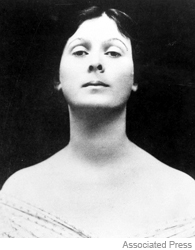One of the most active dancers and choreographers of her time, Isadora Duncan is considered the inventor of Modern Dance. Using dance to express a message of simplicity, purity and oneness, her influence on the dancing world continues to be felt today.
Isadora Duncan’s Early Days
Born on May 27, 1877, Isadora Duncan was the youngest of four children. She was born in San Francisco, and after her parents divorced in 1880, she moved to Oakland with her mother.
She encouraged self-expression so that dancers could create their own styles. Isadora took her love of dancing to Chicago and New York, but her career didn’t flourish there. In search of “artistic fulfillment,” she traveled with her family to Europe, where her dancing grew in popularity and eventually sent her touring throughout Europe and North America, writes the Isadora Duncan International Institute.
Sources in this Story
- Isadora Duncan International Institute: About Isadora Duncan
- DuncanDancers.com: About Isadora Duncan
- The New York Times: The Isadorables: Cherishing the Duncan Legacy
- The New York Times: Isadora Duncan to Quit the Stage
- Center For Sutton Movement Writing: DanceWriting: Isadora Duncan
Duncan’s Dance Career
During her time in Europe, Duncan developed a deep appreciation for Greek culture. She identified with Greek philosophies, ceremonies and rituals, both in her dance and her personal life. She even danced out the images she saw in Greek art.
When she wasn’t dancing, Duncan could be seen wearing Grecian tunics. It was all part of the persona she developed, which would ultimately help formulate her distinct art form. According to the Isadora Duncan International Institute, these ideologies propelled her into the public eye as a figure for “social justice and freedom for the human body and spirit.”
Duncan’s revolutionary changes to dance involved the combining of ballet, ballroom and burlesque dancing styles. She also danced to musical masters such as Beethoven, Brahms and Mozart—musicians who were considered “above” dance, DuncanDancers.com says.
She took her style of dance and thinking to Europe and Russia, where she opened several schools of dance. It was at a school in Germany that “Les Isadorables,” a prize group of pupils, came into existence, joining Duncan on her tours.
Duncan legally adopted the six Isadorables, all of whom took the Duncan name. The six women, that last of whom died in 1987, helped carry on Duncan’s legacy, teaching her choreography to new generations of dancers. Maria-Theresa Duncan went on to found the Isadora Duncan International Institute.
The New York Public Library features multiple portraits of Isadora Duncan and photos of her dancing.
The Woman and Her Work
The Rest of the Story
In 1913, Duncan announced her retirement from the stage following the death of two of her children in a car accident. The New York Times reported that the grief-stricken mother said that once she had taken time to recover from the shock of losing her children, she would join the Bulgarian Red Cross and care for sick individuals as a hospital nurse. However, she ultimately returned to dancing and choreography.
Like her children before her, Isadora Duncan was killed in a car accident. On September 19, 1927, she was sitting in a convertible car wearing a long, trailing scarf. As the car was moving, the scarf became entangled in the rear wheel of the vehicle; Duncan was strangled and pulled from the automobile.











